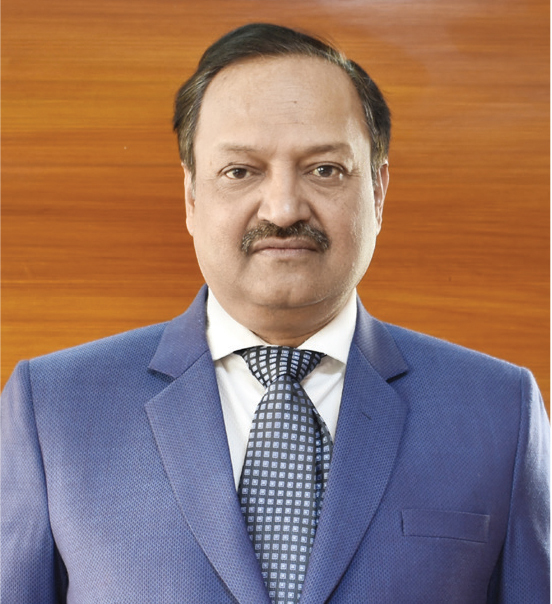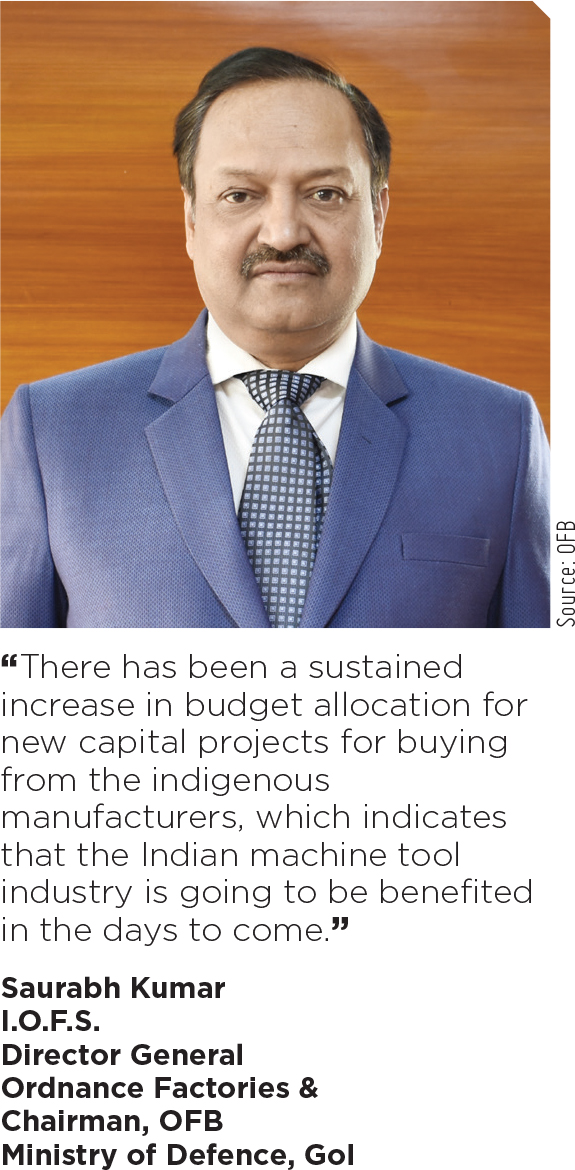Boosting India's Defence



155 mm x 45 calibre artillery gun ‘Dhanush’ 155 mm Up-Gun ‘Sharang’
In an exclusive interview with Team MMI, Saurabh Kumar, I.O.F.S., Director General, Ordnance Factories & Chairman, Ordnance Factory Board (OFB), Ministry of Defence, Government of India, shares how it is to shoulder a mammoth responsibility of his position, the board’s contribution to the growth of the machine tool industry, indigenization of defence manufacture and India’s gradual rising as a defence export hub.
You are an expert in the manufacture of ordnance and have been in the Ministry of Defence as Director of Planning and Coordination for quite some time. Please share your experience in holding a portfolio of Director General, Ordnance Factories and Chairman of Ordnance Factory Board (OFB) since the board shoulders a humungous task of looking after the operations of 41-odd Ordnance Factories across the country.
Saurabh Kumar : It is indeed an honor and, at the same time, a tremendous responsibility to assume leadership of the oldest and largest defence manufacturing organization in the country. Not only do we have a glorious history behind us, but we also have an exciting future ahead.
The Ordnance Factories supply a highly extensive range of weapons and equipment which requires mastery of different technologies and expertise in diverse areas.
OFB is the only organization in the world which makes the entire range of ammunition from 5.56 mm to 155 mm and weapons from the 5.56 mm INSAS rifle to 155 mm x 45 calibre ‘Dhanush’ artillery gun system. At another level, the Metal and Steel Factory at Ishapore is the world’s largest manufacturer of weapons grade steel from secondary sources.
What are the plans drawn by OFB through ‘Make in India’ initiative to make the country self-sufficient in the production of arms and ammunition with the twin objectives of reducing imports and meeting nation’s requirements?
Kumar : OFB has always been committed to the development of indigenous manufacturing capability and our products have an overall indigenous content of over 90 percent.
OFB’s contribution to ‘Make in India’ saw the handing over of the 100 percent indigenous engines of T-72 and T-90 tanks in July last year. Ordnance Factory Bhandara’s achievement of providing the extended double based boosters and sustainer propellant for the propulsion of the ‘Helina’, a helicopter-launched anti-tank missile; the successful testing of the ‘Pinaka’ rocket at Pokhran in July 2018 and the subsequent clearance accorded by ARDE Pune are significant milestones in this direction.
OFB has signed a contract with the Ministry of Defence (MoD) in October 2018 for up-gunning 300 existing 130 mm M-46 artillery guns to 155 mm/45 calibre over a period of four years. This gun is known as ‘Sharang’. The first-ever indigenous 155 mm x 45 calibre artillery gun ‘Dhanush’ has been handed over to the Indian Army in April 2019. ‘Dhanush’ is the first long-range artillery gun system being produced in India and it is a major success story of the ‘Make in India’ initiative.
 To what extent is OFB placing thrust on indigenization? How has the board contributed to the growth of the machine tool industry?
To what extent is OFB placing thrust on indigenization? How has the board contributed to the growth of the machine tool industry?
Kumar : OFB has been continuously supporting the machine tool industry since its inception, especially after independence. There has been a consistent investment over the past years, both for the purchase of new machinery and replacement of old and obsolete plants. Capital has been invested in new projects at a steady rate in the last three financial years. There has been a sustained increase in budget allocation for new capital projects for buying from the indigenous manufacturers, which indicates that the Indian machine tool industry is going to be benefited in the days to come. The indigenous content in our renewal and replacement of existing machinery is also growing up steadily.
OFB’s new procurement manual has come up with several vendor-friendly measures. In addition, vendor meets have been initiated in the factories every month, and every quarter at the Board level. Many factories have launched apps for providing information to vendors regarding the status of contracts and payments. This is also a trend that will gather momentum in the days to come.
OFB is committed to the policy of indigenous manufacturing. It has recently indigenized the Track Assembly for the T-72 Tank; Turbo Charger for the T-90 Tank; Gyro Drift Indicator for the BMP-II; Power Unit Y7K for the T-90 Tank; Automatic Control Unit for the Missile Information Block of the T-90 Tank; Electro-Pneumatic Valve; Mine Protected Vehicle (MPV) and Modernized Mine Protected Vehicle (MMPV); Bi-Modular Charge System (BMCS) for the 155 mm artillery ammunition, 7.62 x 39 mm Assault Rifle ‘Ghatak’; Chaff Launcher ‘Kavach MOD-II’ and Chaff Naval Gun CRN-91; Aerial Bombs; Night Vision Devices for the Armoured Fighting Vehicles BMP-II; T-72 Tank; T-90 Tanks and variants based on image intensification and thermal imaging; Under Barrel Grenade Launcher etc.
Currently, about 20 percent of our turnover is from products developed through in-house R&D and this is set to increase.
OFB is presently developing an upgraded BMP-II, a Futuristic Infantry Combat Vehicle (FICV), an Air Defence Gun and a 155 mm x 52 Cal Mounted Gun System and related ammunition and electronic fuzes.
Besides catering to the forces, the board is also meeting the requirements of advanced technological materials for research establishments like ISRO, DMRL, NFC and others.
The larger goal of indigenizing defence manufacture is to eventually become an exporter of defence equipment. How far have we come in this regard?
Kumar : Apart from establishing the credentials of OFB as a world-class manufacturer of artillery, the ‘Sharang’ and the ‘Dhanush’ guns have also aroused interest of other countries. The board is also receiving queries related to export of these weapon systems.
Our products have been exported to various regions of the world, covering developing as well as developed nations in the Middle East, West Asia, South Asia, South East Asia, Europe and beyond. An array of products ranging from arms and ammunition, weapon spares, chemicals, explosives and troop comfort items have been exported.
The high quality standards of OFB have also gained recognition in international circles and the board has begun exporting 155 mm barrels for testing purposes to a renowned armament manufacturer. OFB has the potential to be a major exporter of artillery as our systems not only meet the performance parameters required by other countries, but are also cost-effective.
OFB is now an established exporter of 155 mm ammunition. More queries are being received for 155 mm and other calibres too. This will receive a further boost with the installation of the latest digital X-ray at Ordnance Factory Bolangir which will further enhance confidence in the quality of ammunition, thereby increasing the demand for our products.
There is a growing recognition of OFB as a supplier of explosives such as TNT, DNT and RDX. This too is an area which is likely to see growth in the years to come.
Another area where exports have been showing an increasing trend is that of Brake Parachutes for fighter aircraft. OFB has been exporting SU-30 parachutes to South East Asia and now more markets are likely to become accessible, given our cost advantage.These achievements also meet the Government’s stated objective of increasing defence exports and earning precious foreign exchange.
We are exploring new markets in Africa and the developing world. Apart from exporting established products, the board’s technological expertise is also leading to enquiries for new products and also for technical expertise in turnkey projects.
Pro-active marketing through participation in international exhibitions and interaction with visiting delegations from target countries and resource firms, along with valuable support from Indian Missions in promotion of products manufactured by the Indian Ordnance Factories, has enabled OFB to establish viable contacts with firms based in India as well as abroad, which act as conduits for boosting exports.
Brake Parachute To keep pace with contemporary manufacturing technologies, OFB has undertaken modernization of ordnance factories. How does the board plan to pan it out?
To keep pace with contemporary manufacturing technologies, OFB has undertaken modernization of ordnance factories. How does the board plan to pan it out?
Kumar : We have spearheaded the modernization program which includes induction of robotic forging technology, new generation CNC machines, predictive maintenance, application of artificial intelligence etc, which will enhance productivity and quality of our products.
There is a conscious effort to harness the advantage of the cluster of new age technologies which collectively makes Industry 4.0.
The rapid pace of technological change has shortened the life cycle of products. OFB has to keep introducing new products so as to retain relevance in the market. To face the upcoming challenges, we have identified the key areas and accordingly launched 17 R&D growth driver projects.
Great organizations survive by transforming themselves. Transformation has to be all encompassing and simultaneous. Total transformation is envisaged in four broad and interconnected areas: Customer focus; Modernization of plant layout and production process with a view to enhancing productivity; Policies for creating a knowledgeable and motivated work force; and Effective communication for enhancing brand image.
Customer focus helps us to understand the need of the customer better and also to increase the confidence of the customer in our products. Customer requirements – both current and future – and the need to eliminate waste and the shift to international MIL/NATO standards are driving the modernization process.
Once the customer’s requirements are known they have to be incorporated in the products and these products have to be produced reliably and safely at acceptable levels of quality and have to be supplied cost-effectively on time.
For this, the ordnance factories are modernizing the production system to be dependable, fast, lean and safe.
As part of the endeavor to have a highly skilled and motivated workforce, employees at all levels are encouraged to increase their knowledge levels by applying for higher educational qualifications. Personnel systems are also being geared to be more responsive and transparent.
A comprehensive system of communication with various stakeholders and proactive public relations policies are being put in place to enhance brand image, visibility and recall.
The first-ever indigenous 155 mm x 45 calibre artillery gun ‘Dhanush’ has been handed over to the Indian Army in April 2019. ‘Dhanush’ is the first long-range artillery gun system being produced in India and it is a major success story of the ‘Make in India’ initiative.
Vast opportunities exist in the area of export and OFB has made an impact with a quantum leap in exports to over `200 crore.





 Facebook
Facebook Twitter
Twitter Linkedin
Linkedin Subscribe
Subscribe